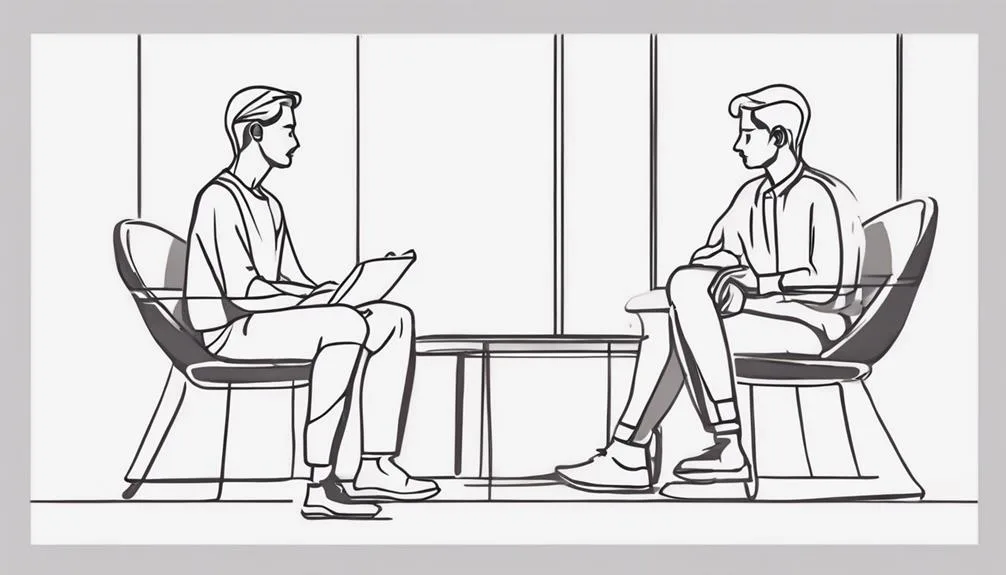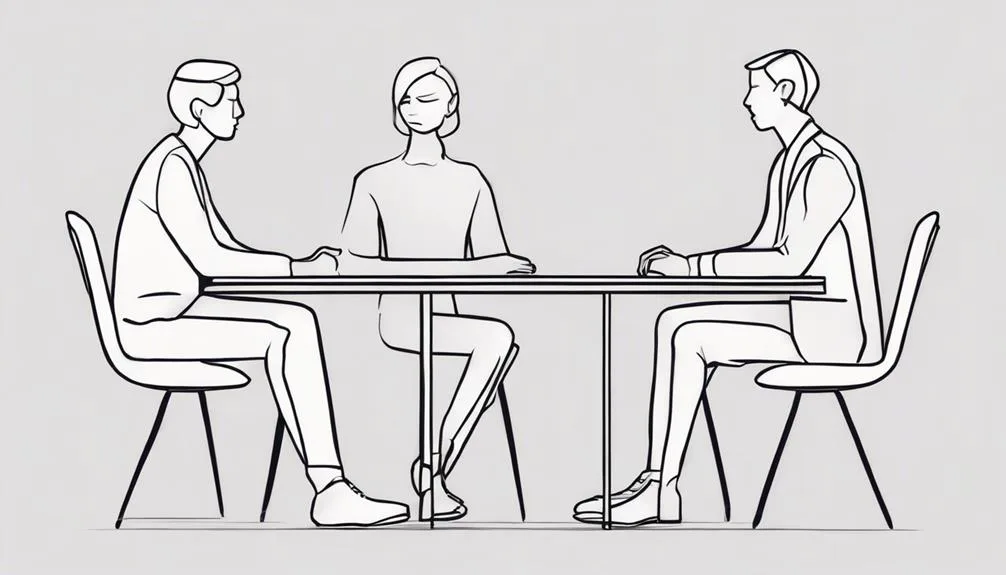Discover 8 simple tips to improve communication in your relationships.
From active listening to showing empathy, these strategies can make a big difference in how you connect with your partner.
But did you know that nonverbal cues play a role too?
Stay tuned to learn how mastering these tips can enhance your interactions with loved ones.
Active Listening

Do you truly listen when your partner speaks, or are you just waiting for your turn to talk? Active listening is a cornerstone of effective communication in any relationship. It involves fully concentrating on what your partner is saying, understanding their message, and responding thoughtfully. To actively listen, put aside distractions, make eye contact, and show genuine interest in what your partner is sharing.
When you practice active listening, you demonstrate respect and care for your partner's thoughts and feelings. By giving them your full attention, you create a safe space for open and honest communication. Remember, effective communication is a two-way street. It's not just about expressing yourself but also about being present and engaged when your partner is speaking.
Next time you have a conversation with your partner, try to focus on active listening. Avoid interrupting or formulating your response while they're still talking. Instead, listen attentively, ask clarifying questions, and validate their emotions. Active listening can strengthen your bond, foster understanding, and improve overall communication in your relationship.
Empathy and Understanding
In cultivating a deeper connection with your partner, practicing empathy and understanding is key to nurturing a strong and healthy relationship. Empathy exercises can help you put yourself in your partner's shoes, seeing things from their perspective. This practice fosters a sense of emotional connection and shows your partner that you value their feelings. Understanding emotions involves actively listening to your partner's needs and concerns without judgment. It's important to acknowledge and validate their feelings, even if you may not fully understand them at first.
To strengthen empathy in your relationship, try sharing your own vulnerabilities and emotions with your partner. This openness can create a safe space for both of you to express yourselves freely. Additionally, when conflicts arise, focus on understanding each other's emotions rather than trying to win the argument. By prioritizing empathy and understanding, you build a solid foundation for effective communication and a more fulfilling connection with your partner.
Clear and Direct Communication

When it comes to effective communication in your relationships, remember to be explicit and honest with your words. By staying focused on your message, you can avoid misunderstandings and convey your thoughts clearly.
Make sure to listen without distractions, showing your partner that you value what they've to say.
Be Explicit and Honest
To foster healthy and effective communication in your relationships, always remember to be straightforward and sincere in expressing your thoughts and feelings.
Direct communication and open dialogue are vital in building trust and understanding between you and your partner. Honest conversations and clear communication lay the foundation for a strong and lasting bond.
When you speak openly and honestly, you create a safe space for both parties to share their perspectives without fear of judgment. Being explicit about your emotions and intentions helps prevent misunderstandings and promotes a deeper connection.
Stay Focused on Message
Focus on conveying your message clearly and directly to guarantee effective communication in your relationship. When communicating, make sure your words align with your intentions. Being clear and direct helps prevent misunderstandings that can lead to unnecessary conflicts. Stay focused on the message you want to convey, avoiding unnecessary details or beating around the bush. Use simple language that accurately reflects your thoughts and feelings. Here is a helpful table to guide you on staying focused on your message:
| Focus | Clarity |
|---|---|
| Be specific | Avoid ambiguity |
| Stay on topic | Use simple language |
| Express your thoughts clearly | Check for understanding |
| Communicate your intent | Be direct |
Listen Without Distractions
Staying fully present during conversations, without allowing distractions to interfere, is key to achieving clear and direct communication in your relationship. When you eliminate distractions and truly listen to your partner, you show them respect and value their words.
Here are three effective listening techniques to help you strengthen your connection:
- Maintain eye contact: By looking into your partner's eyes, you convey your attentiveness and show that you're engaged in the conversation.
- Avoid interrupting: Let your partner express themselves fully without interruptions. This shows that you value their thoughts and opinions.
- Validate what you heard: Reflect back what your partner said to affirm you understood them correctly and to validate their feelings.
Nonverbal Cues Matter

When it comes to relationships, your body language plays an essential role in how your message is received.
Maintaining eye contact signals confidence and attentiveness, which can strengthen the connection between you and your partner.
Body Language Importance
Nonverbal cues, such as body language, play an important role in effective communication, often conveying more than words alone. Being mindful of your posture and gestures can have a major impact on how your message is received. Here are three key points to remember:
- Posture Awareness: Your body posture can speak volumes about your feelings and attitudes, influencing the overall communication effectiveness. Make sure to maintain an open and relaxed posture to signal approachability and receptiveness.
- Facial Expressions: Your facial expressions are powerful tools for creating an emotional connection with your partner. A smile can convey warmth and friendliness, while frowns or grimaces may signal discomfort or disagreement.
- Eye Contact: Eye contact is important for building trust and showing attentiveness. It's a crucial component of effective communication that fosters connection and understanding between partners.
Eye Contact Signals
Your partner's eyes can reveal a wealth of unspoken emotions and intentions, making eye contact a pivotal nonverbal cue in relationship communication. Nonverbal communication plays a fundamental role in understanding your partner's feelings when words fall short.
When engaging in a conversation, maintaining appropriate eye contact shows that you're attentive and interested in what your partner is saying. It can convey empathy, sincerity, and connection, building trust in the relationship. However, be mindful of cultural differences as eye contact norms vary. Too much or too little eye contact can send mixed signals.
Practice finding a balance that feels comfortable for both you and your partner, ensuring that your nonverbal cues enhance rather than hinder your communication.
Practice Patience
To improve your relationship communication, it's essential to cultivate patience as a foundational skill. Cultivating patience in your interactions can greatly enhance the quality of your relationships. Here are three key ways practicing patience can benefit your communication:
- Understanding: Patience allows you to listen actively and understand your partner's perspective without jumping to conclusions. By giving them the time they need to express themselves fully, you show that you value their thoughts and feelings.
- Conflict Resolution: When faced with disagreements or conflicts, patience helps you remain calm and collected. It gives you the space to think before reacting impulsively, leading to more constructive discussions and effective problem-solving.
- Emotional Connection: Patience fosters a deeper emotional connection with your partner. By being patient and attentive, you create a safe space for open communication, vulnerability, and trust to flourish, ultimately strengthening your bond.
Use "I" Statements

When managing communication in your relationship, utilizing 'I' statements can be a powerful tool for expressing your thoughts and feelings effectively. 'I' statements focus on self-awareness and emotional intelligence, allowing you to take ownership of your emotions and communicate them clearly to your partner.
By starting your sentences with 'I feel' or 'I think,' you shift the conversation from blaming or accusing to expressing how you personally perceive a situation. Embracing 'I' statements requires practice and mindfulness. It involves recognizing your emotions in the moment and articulating them in a way that promotes understanding rather than conflict.
By being aware of your own feelings and using language that reflects your internal experiences, you show respect for yourself and your partner. This highlights emotional intelligence and encourages mutual respect within the relationship.
Give and Receive Feedback
To enhance your relationship communication, it's important to develop the skill of giving and receiving feedback effectively. Constructive feedback can be a powerful tool for growth and understanding within a relationship. Here are three key points to contemplate when giving and receiving feedback:
- Give Constructive Feedback: When offering feedback to your partner, focus on specific behaviors or situations rather than general criticisms. Use 'I' statements to express your feelings and avoid blaming language. For example, instead of saying, 'You never listen to me,' try saying, 'I feel unheard when I'm speaking, and it's important that we communicate openly.'
- Receive Constructive Feedback: When receiving feedback, practice active listening. Try to understand your partner's perspective without becoming defensive. Ask clarifying questions to make sure you grasp their point of view before responding. Acknowledge their feelings and show empathy towards their concerns.
- Work Together: Remember that feedback is a two-way street. Encourage open communication and a willingness to grow together. By giving and receiving feedback respectfully, you can strengthen your bond and foster a deeper understanding in your relationship.
Set Boundaries

Effective communication in relationships often involves setting clear boundaries to guarantee mutual respect and understanding. It is essential to establish boundaries that help define what is acceptable and what is not in a relationship. Respecting limits is vital for maintaining a healthy and harmonious connection with your partner. Here are some practical tips to help you navigate the process of setting boundaries effectively:
| Tips for Establishing Boundaries | Description | Example |
|---|---|---|
| Clearly communicate your needs | Express your needs and desires openly to make sure your partner understands what is important to you. | 'I need some alone time to recharge after work.' |
| Be assertive but respectful | Assert your boundaries firmly yet respectfully, considering your partner's feelings in the process. | 'I appreciate your concern, but I prefer making my own decisions about my career.' |
| Consistently enforce boundaries | Stick to the boundaries you've set to show that they are important and non-negotiable in the relationship. | If your partner continues to disrespect your boundaries, have a calm discussion about why it's vital to you. |
Conclusion
By embracing active listening, empathy, clear communication, and patience, you lay a solid foundation for thriving relationships. Pay attention to nonverbal cues, set healthy boundaries, and welcome open feedback.
These practices nurture understanding and harmony, enriching connections. Trust in the power of communication to sustain and deepen your bonds.

